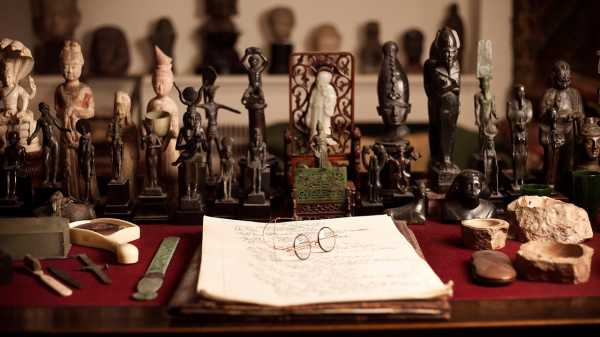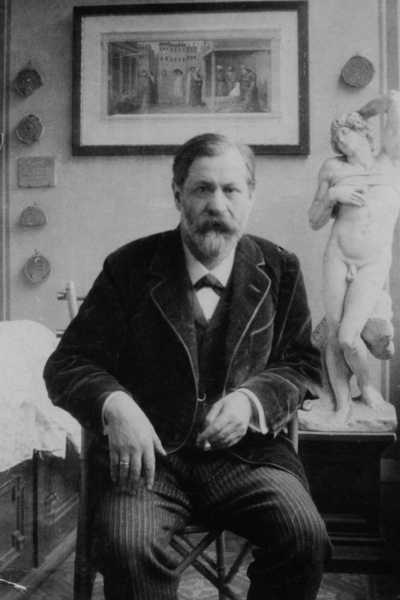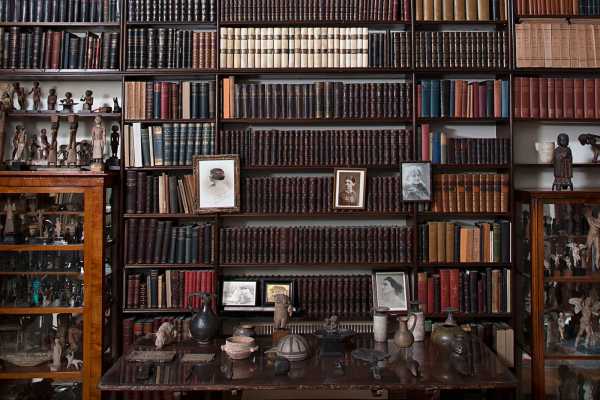
Save this storySave this storySave this storySave this story
In the spring of 1938, the Nazis were circling like vultures around Berggasse 19, the Vienna home of Sigmund Freud. The German Reich had annexed Austria on March 13th, and Hitler paraded through Vienna the next day, to the cheers of supporters and the terror of the city’s Jews. “Finis Austriae,” Freud wrote in his diary. A swastika was hung above the entrance to his building. His books were destroyed and his publishing house seized. Storm Troopers swooped through his apartment, helping themselves to money. The Nazis had no interest in Freud’s psychoanalytic theories, which they deemed “degenerate,” but the looters may have had their eyes on the doctor’s astonishing collection of antiquities.
Since the eighteen-nineties, Freud had been collecting ancient artifacts, amassing a private museum of more than two thousand Greco-Roman statues, busts, Etruscan vases, rings, precious stones, Neolithic tools, Sumerian seals, Egyptian mummy bandages, Chinese jade lions, and Pompeiian penis amulets. He went treasure hunting in markets in Vienna, Salzburg, Florence, and Rome. After returning home with a new trophy, he would bring it to the dinner table as a companion, and he often lined up favorites on his desk. “I must always have an object to love,” he confessed to Carl Jung. Freud even took his “old and grubby gods,” as he called them, on holiday with him. “I have sacrificed a great deal for my collection of Greek, Roman and Egyptian antiquities,” he wrote to the novelist Stefan Zweig, adding that he had “actually read more archaeology than psychology.”
On March 22nd, the Gestapo arrested Freud’s daughter Anna and carted her away for interrogation. She returned home unharmed, but the ordeal confirmed the family’s need to flee. A network of international supporters began scheming to get Freud out of Austria. Would his beloved collection make it with him? While the Gestapo waited outside his apartment, Freud’s friend and pupil Marie Bonaparte, the great-grandniece of Napoleon, smuggled out two of his favorite objects—a small bronze statuette of Athena and a Chinese jade screen—by stashing them in her handbag.
Freud arrived in London with his wife and daughter on June 6, 1938. The rest of his belongings, including his psychoanalytic couch, followed soon after. (He was again indebted to Bonaparte, who paid the Nazis a heavy ransom, in the guise of an income tax, to get Freud and his objects to safety.) The family moved into a brick house on a quiet residential street in Hampstead, in North London. Now known as the Freud Museum, it’s an unremarkable home with typical bourgeois trappings—plants, books, family photographs, heavy Austrian furniture. But one of its rooms—a long, rectangular space that runs the length of the house—is anything but typical. It is Freud’s study, a strange, shamanic place, packed to the brim with his old and grubby gods.

Sigmund Freud next to his copy of Michelangelo’s “The Dying Slave,” in 1911.Photograph courtesy Freud Museum London
Why did Freud, a self-described “godless Jew,” surround himself with pagan idols? And how did these objects influence his theories? A new exhibition at the Freud Museum, “Freud’s Antiquity: Object, Idea, Desire,” seeks to provide an answer. On a recent evening, psychologists, students, and scholars wandered the rooms, sipping wine and prattling about the collection. Entering the study, which has been preserved as Freud left it, feels like stepping into Aladdin’s Cave of Wonders. The walls are lined with dark, leather-bound books and glass cabinets showcasing rows upon rows of statuettes and figurines. There’s a table crowded with ancient vases and tools salvaged from an archeological dig. Various Greco-Roman busts stare from their pedestals. In the middle of the room sits Freud’s desk, still cluttered with his favorite objects, and on the far wall is the psychoanalytic couch, draped in an Oriental rug. (“The most famous couch in the whole world,” a visitor at my side whispered.) At the head of the couch is a green upholstered accent chair, where Freud sat to listen to his patients. The chair could pass as part of Anthropologie’s vintage collection, but little else in the room would win the approval of an interior decorator. The objects are not aesthetically arranged or displayed to advantage; they are crowded, even hoarded, and stacked so thickly that it is difficult to take them in.
“People don’t tend to look at Freud’s theories in line with his collecting habits,” Tom DeRose, a research manager at the museum, told me. “It’s almost seen as an embarrassment now,” Miriam Leonard, the exhibition’s co-curator, added. “This is Freud the strange Victorian who does all this collecting, but that’s different from Freud the inventor of talking therapy.” The exhibition contends that the collecting and the theorizing cannot be separated—that each fed the other.
I studied a glass case displaying Freud’s collection of tiny penis amulets. He had seventeen phalluses but only one vulva.
“Who do you think dusted them all?” a psychotherapist near me asked. The answer, in fact, is his housekeeper, Paula Fichtl, who tended to Freud’s treasures for some fifty years.
Freud began collecting in 1896, shortly after the death of his father. “In [my] inner self,” he reflected, “I now feel quite uprooted.” Around the same time, he began his self-analysis, digging into his unconscious in the work that would become “The Interpretations of Dreams.” “I arrived at a procedure which I later elevated to a method,” Freud wrote. “The procedure of clearing away, layer by layer, the pathogenic psychical material, which we like to compare with the technique of excavating a buried city.” Captivated by Heinrich Schliemann’s account of the excavation of Troy, Freud began to think of the mind as an archeological site. “The psychoanalyst, like the archeologist, must uncover layer after layer of the patient’s psyche, before coming to the deepest, most valuable treasure,” he told one of his patients. The treasure, of course, was the cause of neurotic symptoms, deeply buried in the unconscious. “There is, in fact, no better analogy for repression, by which something in the mind is at once made inaccessible and preserved, than burial of the sort to which Pompeii fell a victim and from which it could emerge once more through the work of spades,” he wrote.
Archeology furnished Freud with a glamorous metaphor—a means of imbuing psychoanalysis with scientific authority and imagistic clarity. Excavation takes time, its daily work is mundane, and the archeologist’s discoveries are often incidental. “I think he was drawn to the idea that the things we think of as ephemeral or undramatic memories are pivotal,” Leonard said.
For Freud, displaying treasures in the room where he received patients made the metaphor tangible. “One of the problems of dealing with the unconscious—one of the defenses—is to think, Well, it doesn’t really exist,” Richard Armstrong, another co-curator of the exhibition, told me. “If you look at the artifacts, they’re like pledges that the past is real. Everything is ultimately accessible, if you could only get around the censorship.” Freud’s work often focussed on making invisible connections palpable, and his objects, as Leonard put it, symbolized the profound link “between the idea of human history and childhood history.” “The past is way more complex and vaster than we know,” Armstrong added. “And when you think about that, at the individual level, it’s a really key point. Because most of us don’t want to go back and think about the sibling and parental dynamics of our early life.”
The strange faces that stare down from Freud’s shelves—satyrs, two-faced figures, gods of love and death and war—do look like the kinds of faces that we might see in our dreams. A Greek water jug depicts Oedipus, the ill-fated Theban hero, confronting a sphinx, a lion with the head of a woman and wings. Oedipus is solving the sphinx’s riddle, an image that was particularly potent for Freud. But what would it have been like to be Freud’s patient—especially in this room? The space is overbearing. It is, in fact, almost too suggestive.

Photograph by Karolina Heller / Courtesy Freud Museum London
“Now you would never have a consulting room like this,” a psychologist told me. The modern therapy setting is minimalist—a white cube with perhaps a few books and an orchid in the corner. But Freud’s patients seem to have enjoyed his study. “There was always a feeling of sacred peace and quiet here,” Sergei Pankejeff, who sought treatment with Freud in Vienna, wrote. “Everything here contributed to one’s feeling of leaving the haste of modern life behind, of being sheltered from one’s daily cares.”
The poet H.D. (Hilda Doolittle) was especially stunned by Freud’s collection. “I can not speak,” she wrote. “A lover of Greek art, I am automatically taking stock of the room’s contents. Pricelessly lovely objects are displayed here on the shelves to the right, to left of me . . . I was to greet the Old Man of the Sea, but no one had told me of the treasures he had salvaged from the sea-depth.” Freud took pleasure in showing H.D. his objects, but she wasn’t sure if this was a social gesture or part of his analytic plan. “Did he want to find out how I would react to certain ideas embodied in these little statues, or how deeply I felt the dynamic idea still implicit in spite of the fact that ages or aeons of time had flown over many of them?” she reflected. “Or did he mean simply to imply that he wanted to share his treasures with me, those tangible shapes before us that yet suggested the intangible and vastly more fascinating treasures of his own mind?”
In the study, a group of analysts recounted an occasion when Freud showed H.D. his bronze statue of Athena, the goddess of war and wisdom. “This is my favorite,” he told her. “She is perfect, only she has lost her spear.” The anecdote, with its heavy Freudian implications, provoked peals of laughter.
Yet one wonders whether a spear is just a spear, and whether Freud’s hobby has a simpler explanation, rooted in pleasure and personality. Collecting has been theorized as a coping mechanism for loss; Freud was thrust into grief after his father’s death, but he never analyzed his compulsion to hoard objects from the past. “Why do you think he collected all this stuff?” I asked the analyst who was staring at the penis amulets with me.
“Because he was obsessive!” she said. “You have to be obsessive to be a shrink. We’re all obsessive.”
Freud’s time in London was short-lived. Suffering from cancer of the jaw, he had a bed set up in his study, and, on September 22, 1939, his doctor administered several doses of morphine. Freud died the next day, surrounded by his pagan gods. ♦
Sourse: newyorker.com






